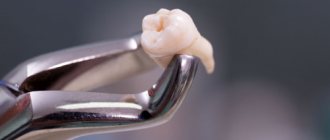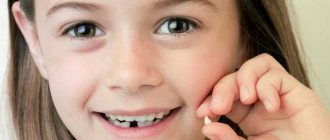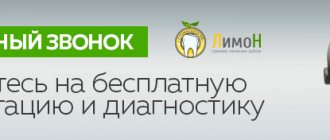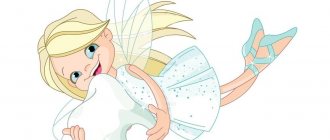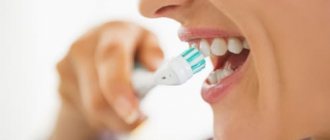Does your child have a loose baby tooth? Many parents do not know how to act in this situation. On the one hand, the process of replacing baby teeth with permanent ones is absolutely natural. On the other hand, some mothers and fathers begin to worry: how to remove a baby tooth correctly - pull the tooth out at home or seek help from a specialist. Find answers to these and other questions in our article.
Causes of loss of baby teeth
As a rule, at the age of 5, a child’s first milk tooth begins to loosen. This is an absolutely natural, physiological process that happens to every child: the root of a baby tooth dissolves, the tooth begins to be held in place only by the gums, gradually loosening and eventually falling out. However, if the tooth fell out much earlier, this situation can no longer be considered normal. Baby teeth fall out prematurely due to:
- Tooth injuries
- Vitamin deficiency
- Rakhita
- Diabetes
- some genetic diseases
In most cases, these diseases can be treated, the main thing is to seek medical help in time.
If a tooth falls out a year or more ahead of schedule, this can lead to improper development of the bite and slow jaw growth. In this case, long-term orthodontic treatment will be required.
In addition, parents should pay attention to the following points:
Long process of falling out
If a child's baby tooth becomes loose for a long time but does not fall out, it can cause discomfort to the child, preventing him from eating and speaking. The gums around the tooth may become inflamed and painful.
Deterioration of the child's well-being
If a child has a loose tooth and, as a result, the temperature rises, loss of appetite, nausea and vomiting occur - first of all, seek advice from a pediatrician, and secondly - from a dentist.
Causes of the anomaly
If the permanent tooth is erupting but the baby tooth has not fallen out, it can be assumed that the child is not eating enough solid food. With a deficiency of chewing load, the roots of temporary units are in no hurry to dissolve.
The diet of modern children is indeed too “gentle”, one might even say refined. It consists of products that have undergone step-by-step heat treatment. Chewing them requires almost no effort.
If parents think that children need to be given soft and thoroughly steamed food, then they are mistaken. To change teeth in a timely manner and form a correct bite, you need to eat a lot of fresh vegetables and fruits, and other foods that require careful chewing. Then the problem of preserving primary canines, incisors and molars for too long will not arise.
Another possible cause of the problem described is the presence of scars on the gums. If in the first years of life the baby has undergone dental surgery or received a serious injury, a burn to the oral cavity, scars may form on his gums. They consist of very dense connective tissue that prevents teeth from erupting.
How children's baby teeth are removed in the clinic
The structure of primary teeth is characterized by a number of features. Thin alveolar walls, low crowns, and lateral roots require special care, attention and skill from the doctor during the removal procedure. One wrong move and you can damage the buds of permanent teeth. For this reason, it is very important to find an experienced pediatric dentist who will not only carefully carry out the procedure for removing a baby tooth, but will also quickly find an approach to your child and treat him with care and attention.
Specialists at the Center for Modern Dentistry know how to remove a baby tooth painlessly. Modern painkillers are effective and safe for the child’s body: the child will not feel pain even with complex tooth extraction.
When to see a doctor
Doctors believe that a “shark” smile can last up to two to three months, then it is necessary to take action. If the baby tooth does not fall out within the specified period, it needs to be removed. If you do not do this, the complications described above may occur.
But what’s even worse is that the child’s bite may be disrupted. The permanent unit will take the wrong position or be at the wrong angle. Then you will have to correct its position using plates or braces, and this is always difficult and time-consuming.
It is important to know! If a permanent tooth has come out, but the baby tooth has not yet fallen out, you can monitor the situation for several weeks. It is important to ensure that the child carefully maintains oral hygiene. If after two or three months nothing has changed, you need to make an appointment for your baby to see a dentist. But this recommendation is relevant only if the little patient is not bothered by anything and does not complain of toothache.
What to do after removing a baby tooth
The procedure itself for removing baby teeth is not complicated. However, in order to avoid the development of possible consequences after the removal of a baby tooth, you should follow the following medical recommendations:
- Do not eat or drink for two hours after removal
- Do not eat hot or cold food for two days
- Do not visit the pool or sauna for three days
- Use a soft toothbrush when brushing your teeth
- Do not apply compresses
- Do not rinse your mouth unless your doctor prescribes it.
- Consult a doctor if your body temperature rises above 38 degrees
After a tooth is removed, a blood clot forms at the wound site. It cannot be injured, otherwise it will take a long and painful time to heal. If the wound is bleeding: make a cushion from a sterile bandage, apply it to the removal site and have the child press it with his teeth. If bleeding cannot be stopped within 30 minutes, consult a doctor immediately.
Possible complications
Dry socket, or alveolitis, is the most common complication after tooth extraction, when a blood clot necessary for rapid and favorable wound healing does not form in the socket. Symptoms of alveolitis are: pain in the gums at the site of the extracted tooth, gray plaque in the wound. If alveolitis is not treated in time, it can lead to more serious consequences – osteomyelitis. Therefore, at the first signs of the disease, do not self-medicate, but immediately contact a specialist. The doctor will quickly make a diagnosis, carry out the necessary antiseptic treatment, and prescribe the necessary treatment.
What does a “shark” smile lead to?
Should you be scared if a new unit comes out, but the milk unit does not fall out? This situation should alert parents. Double dentition can lead to problems with articulation and diction. Then the child will have difficulties with the correct pronunciation of sounds and words.
Also, many patients with the described anomaly have difficulty eating food - they feel uncomfortable biting off hard foods, and when chewing them, small particles often get lodged under the gum. This means that the child will get used to swallowing poorly chewed food. This leads to disturbances in the functioning of the gastrointestinal tract, including flatulence and abdominal pain.
It happens that children who have double units in several places at once begin to lose weight. This is again due to improper chewing of food. During a meal, they swallow large pieces and because of this they swallow a lot of air. Therefore, they often have the illusion of satiety - a feeling of fullness when very little has been eaten.
Among the dental complications caused by untimely change of units:
- caries;
- inflammation of the gums;
- deposition of a large amount of soft plaque.
Therefore, you should not put off visiting the dentist. The doctor will conduct an examination and decide whether to remove the extra unit.
How to extract a baby tooth from a child at home
So, we come to the most age-old question for many parents. And the answer to it is ambiguous. On the one hand, when a child’s baby tooth becomes loose, it usually falls out spontaneously, without causing pain or discomfort to the baby. On the other hand, if parents are so eager to take an active part in this process, then they should remember that:
- Children should not be allowed to chew on solid food: apples, carrots, crackers. This can damage the gum tissue.
- You should not try to remove a tooth when the child is crying and resisting. This will cause psychological trauma to your child.
- You cannot remove a tooth using improvised, non-sterile means. You can get an infection in your mouth.
- You cannot put pressure on the tooth or tilt it. This will cause pain to the child and damage the gums.
In addition, risks such as incomplete tooth extraction (when fragments remain in the gum), root fracture, injury to neighboring teeth and bone tissue, damage to the nerve and gums - when removing a tooth at home, increase many times over. In this case, you, as a non-specialist, cannot guarantee that everything will go smoothly and safely.
Therefore, do not waste your time on barbaric and long-outdated methods of removing baby teeth with unpredictable consequences: save your nerves and the health of your child! Make an appointment with a pediatric dentist, where, under sterile conditions, a knowledgeable, experienced doctor, in a cozy office, while showing cartoons, will quickly and painlessly remove the desired baby tooth.
Oral hygiene with a loose tooth
Prevention of childhood caries is so important that its importance cannot be overestimated. This applies not only to indigenous, but also to temporary units. The health of permanent incisors and molars depends on the condition of temporary chewing organs. Therefore, dentists recommend carefully treating the oral cavity of babies. By the age of two, you should visit the dentist for the first time for a preventive examination.
Children's crowns have soft, unformed tissue, so they are very sensitive and vulnerable. Care involves cleaning incisors and molars twice a day. When temporary units become loose and fall out, the gum tissue can become inflamed. Therefore, you need to use high-quality children's toothpaste to gently treat your mouth. Such products are suitable for thin enamel; they prevent caries and do not contain abrasives or fluoride.
Even with mobile units, hygiene procedures must be carried out twice a day to prevent the development of bacteria. Do not touch or pull the organ with dirty hands. If a baby brush does not remove food debris, it should be flossed. This procedure must be done by the mother. It is good if parents encourage their children to be responsible for cleaning their mouths.
Surgical intervention
Comprehensive treatment of a loose tooth is effective in the early stages of the disease. If the loosening of the tooth progresses, then another treatment is prescribed.
Most often, this is a patchwork surgical operation, during which damaged areas of periodontal tissue, which are the source of inflammation, are removed. The operation is preceded by a splinting process. Through this process, the load on the teeth is redistributed.
Tooth extraction is the most extreme method of dealing with lesions that cause looseness. The reason for tooth extraction can be severe mechanical impact or serious injury, when tooth restoration is almost impossible. Our dentists will do everything possible to preserve your natural teeth. Surgical operations in our clinic if you have a loose tooth are kept to a minimum.
Source . The article was prepared based on materials provided by orthopedic dentist, surgeon, candidate of medical sciences Konstantin Anatolyevich Prokopyev. Doctor of the highest category, work experience in the specialty since 1994. In 2010 he defended his Ph.D. Combines practical work with management of a dental clinic.
How is the treatment carried out?
When choosing treatment tactics, the dentist takes into account:
- how old is the patient;
- how long ago the permanent unit emerged;
- how much the molar crown appeared;
- what condition is the milk unit in;
- does the child have any complaints;
- general condition of the dentition;
- the patient has a predisposition to dental anomalies.
After conducting an in-person examination, the dentist decides whether to pull out the interfering tooth or leave it and wait until its roots resolve on their own. In the first case, local anesthesia is administered and removal is carried out; in the second, the doctor tells you when the baby needs to come for a second examination. Thus, if you deal with the problem of a “shark” smile in a timely manner, it will not cause negative consequences.
If there is no tooth, but the others are loose. What should I do?
In this case, we can use removable dentures made from individual impressions. The missing tooth will be covered with an artificial crown.
Pros:
- a removable denture will preserve diction;
- restore the child’s chewing, bite and self-esteem;
- getting used to it will happen very quickly.
The choice of design and material depends on the specific situation. For some injuries, this is the only possible option while the healing process is underway.
Dental implantation
A provocative question: is it possible to put a crown on the root of a tooth? Yes, if this root is an artificial implant made of titanium alloy or even zirconium. Installing an implant solves almost all problems with tooth loss:
- stops bone atrophy;
- completely restores the natural distribution of chewing load;
- no damage to neighboring teeth;
- excellent aesthetic result;
- implant service life - from 25–30 years to lifelong;
- a large number of possible options for creating crowns - ceramics, metal-ceramics, solid zirconium or zirconium with ceramic lining;
- ease of care, no different from the hygiene of natural teeth.
